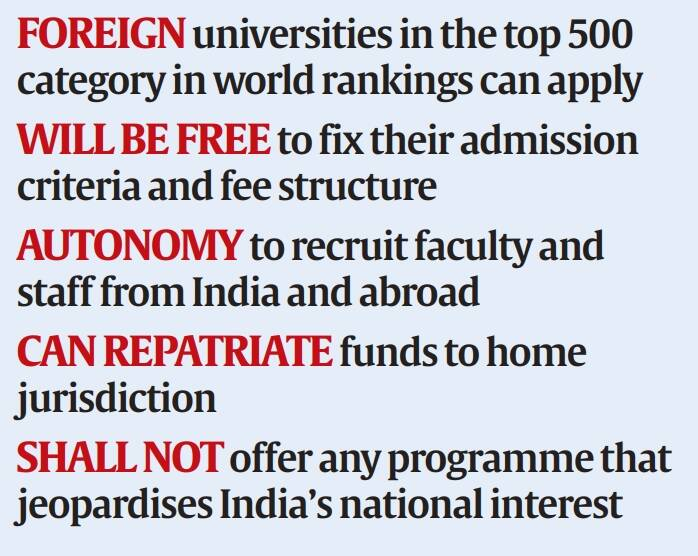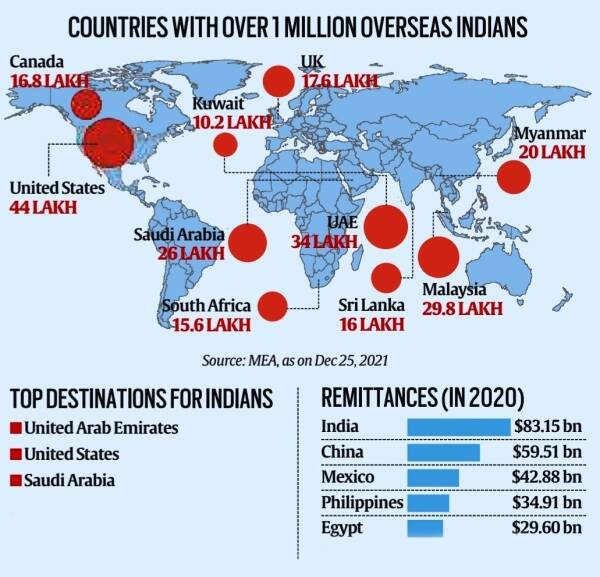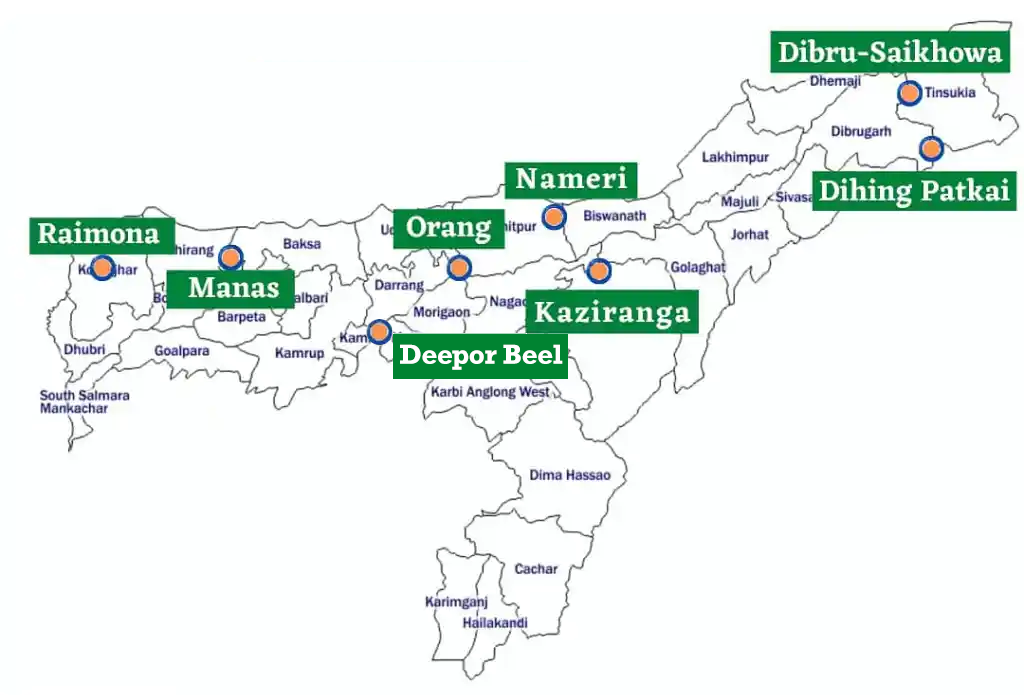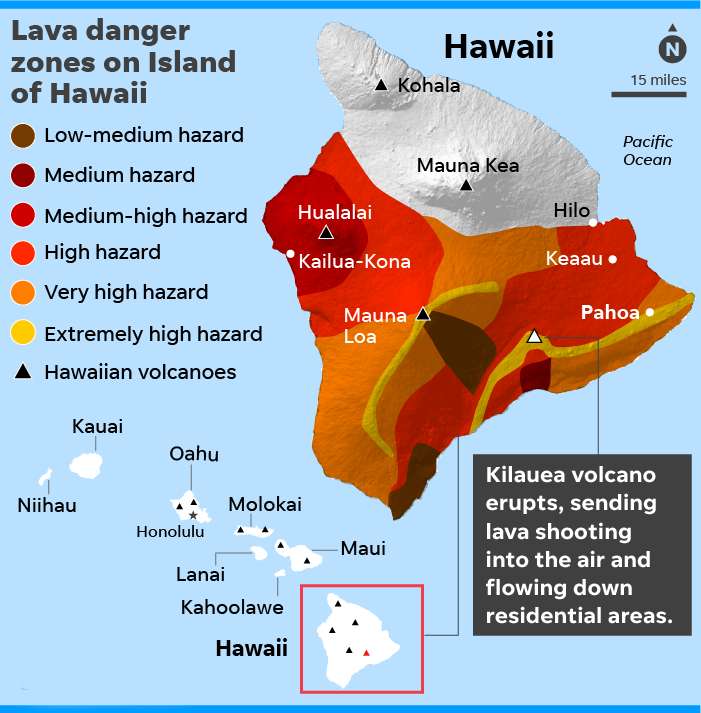Infographics
Governance
Draft Norms Announced by UGC for Foreign Universities
Prelims: UGC, NEP 2020.
Mains: Draft Norms announced by UGC for Foreign Universities and its Significance.
Why in News?
The University Grants Commission (UGC) has announced draft norms for facilitating foreign universities and educational institutions to set up campuses in India which allow them autonomy in decision making.
What are the Draft Norms Announced by the UGC?
- Sets Criteria:
- A foreign university with a rank among the top 500 global rankings or a foreign educational institution of repute in home jurisdiction can apply to the UGC to set up a campus in India.
- Application Process:
- The application will be considered by a standing committee appointed by the UGC which will submit its recommendations within 45 days after examining the institution’s credibility, programmes offered, their potential.
- Subsequently, within 45 days, the UGC may grant in-principal approval to the foreign institution to set up campuses in India within two years.
- The initial approval will be for 10 years, which can be extended.
- Mode of Teaching:
- It will also have autonomy to recruit faculty and staff from India and abroad.
- The courses to be offered cannot be in online and open and distance learning mode.
- The qualifications awarded to the students in the Indian campus should have equivalence with those awarded by the institutions in their country of origin.
- Such universities and colleges cannot offer any such programme of study which jeopardises the national interest of India or the standards of higher education in India.
- Fund Management:
- Foreign universities will be allowed to repatriate funds to parent campuses.
- Cross-border movement of funds and maintenance of Foreign Currency Accounts, mode of payments, remittance, repatriation, and sale of proceeds, if any, will be as per the Foreign Exchange Management Act (FEMA) 1999 and its Rules.
- It will also have the autonomy to decide its fee structure, and will face no caps that are imposed on Indian institutions. The fee should be “reasonable and transparent.
What is the Significance of the Move?
- Nearly 13 lakh students were studying abroad in 2022 according to the Ministry of External Affairs data; and as per the RBI, Rs 5 billion was lost in foreign exchange due to students going overseas in FY 2021-2022
- Allowing foreign universities to set-up campuses in India will also ensure that all our students — there are around 40 million pursuing higher education — have access to global quality education.
- The ideal of setting up foreign universities’ campuses in India is also mentioned in the National Education Policy (NEP) 2020.
- The NEP says that the top 100 universities in the world will be facilitated to operate in India through a legislative framework.
- In a way, the draft regulations released only seek to institutionalize the NEP’s vision.
- This move will pave the way for India to become a global destination for education.
- It will not only help prevent brain drain and loss of forex due to Indian students studying overseas, but also help to attract overseas students to India.
- It will encourage competition among various players in the country, and allow faculty to faculty research collaboration among various universities.
- After Chinese students, Indians are the largest category of foreign students in countries like the U.S., the U.K. and Australia.
What are the Concerns?
- It is believed that the social justice concerns have been ignored which is very important in our context where higher education is very effective means for social change.
- Draft regulations have no provisions for caste-based/economic-based/minority-based/armed forces-based/Divyang-based/Kashmiri migrants/representation-based/women reservation in student admissions.
- Section of educational practitioners has expressed reservations about allowing international universities to operate in India as it would raise the cost of education, rendering it out of reach for a large part of the population.
- Repatriation of funds to the parent institution abroad, which was prohibited previously, has also been allowed.
- There’s also no requirement for foreign education providers to maintain a corpus fund to operate in India.
Way Forward
- If the Indian higher education sector truly opens up, it will be one step forward in India’s aspiration to become a knowledge society again, if not actually a Vishwa-guru.
- Not protectionism and shuttering our intellectual borders, but competition and collaboration with the best will help usher in a true Indian renaissance.
UPSC Civil Services Examination, Previous Year Question (PYQ)
Prelims
Q. Which of the following provisions of the Constitution does India have a bearing on Education? (2012)
- Directive Principles of State Policy
- Rural and Urban Local Bodies
- Fifth Schedule
- Sixth Schedule
- Seventh Schedule
Select the correct answer using the codes given below:
(a) 1 and 2 only
(b) 3, 4 and 5 only
(c) 1, 2 and 5 only
(d) 1, 2, 3, 4 and 5
Ans- (d)
Mains
Q1. How have digital initiatives in India contributed to the functioning of the education system in the country? Elaborate on your answer. (2020)
Q2. Discuss the main objectives of Population Education and point out the measures to achieve them in India in detail. (2021)


International Relations
The Indian Diaspora
For Prelims: Pravasi Bharatiya Diwas (PBD), Non-Resident Indians (NRI), Persons of Indian Origin (PIOs), Overseas Citizens of India (OCIs)
For Mains: Indian Diaspora - Significance
Why in News?
Recently, the Prime Minister inaugurated the 17th Pravasi Bharatiya Diwas convention in Madhya Pradesh on the occasion of Pravasi Bhartiya Diwas (PBD).
- Over the years, the convention, which began in 2003, has grown in size and scope, particularly since 2015, when the yearly convention became a biennial affair.
What is Diaspora?
- Origin:
- The term diaspora traces its roots to the Greek diaspeiro, which means dispersion. The Indian diaspora has grown manifold since the first batch of Indians were taken to counties in the eastern pacific and the Caribbean islands under the ‘Girmitiya’ arrangement as indentured labourers.
- Classifications:
- Non-Resident Indians (NRI): NRIs are Indians who are residents of foreign countries. A person is considered NRI if:
- She/he is not in India for 182 days or more during the financial year Or;
- If he/she is in India for less than 365 days during the 4 years preceding that year and less than 60 days in that year.
- Persons of Indian Origin (PIOs): PIO refers to a foreign citizen (except a national of Pakistan, Afghanistan Bangladesh, China, Iran, Bhutan, Sri Lanka and Nepal) who:
- At any time held an Indian passport, or who or either of their parents/ grandparents/great grandparents was born and permanently resided in India as defined in the Government of India Act, 1935 or who is a spouse of a citizen of India or a PIO.
- The PIO category was abolished in 2015 and merged with the OCI category.
- At any time held an Indian passport, or who or either of their parents/ grandparents/great grandparents was born and permanently resided in India as defined in the Government of India Act, 1935 or who is a spouse of a citizen of India or a PIO.
- Overseas Citizens of India (OCIs): A separate category of OCI was carved out in 2005. An OCI card was given to a foreign national:
- Who was eligible to be a citizen of India on January 26, 1950
- Was a citizen of India on or at any time after January 26, 1950 or belonged to a territory that became part of India after August 15, 1947.
- Minor children of such individuals, except those who were a citizen of Pakistan or Bangladesh, were also eligible for OCI cards.
- Non-Resident Indians (NRI): NRIs are Indians who are residents of foreign countries. A person is considered NRI if:
- Geographical Spread:
- According to the World Migration Report, 2022, India has the largest emigrant population in the world in 2020, making it the top origin country globally, followed by Mexico, Russian and China.
- The data shared by the government in Parliament in 2022 showed that the geographical spread of the Indian diaspora is vast. The countries with over 10 lakh overseas Indians include:
- United States of America, the United Kingdom, United Arab Emirates, Sri Lanka, South Africa, Saudi Arabia, Myanmar, Malaysia, Kuwait and Canada.
- Remittances:
- According to the World Bank Migration and Development Brief, released in 2022, for the first time a single country, India, is on track to receive more than USD 100 billion in yearly remittances.
- The World Migration Report notes that India, China, Mexico, the Philippines and Egypt are (in descending order) among the top five remittance recipient countries.
What is the Significance of the Indian Diaspora?
- Enhancing India’s Soft Power: Indian diaspora is one of the richest minorities in many developed countries. Their advantage is evident in “diaspora diplomacy”, whereby they act as “bridge-builders” between their home and adopted countries.
- The Indian diaspora is not just a part of India’s soft power, but a fully transferable political vote bank as well.
- Also, many people of Indian origin hold top political positions in many countries, which enhances India’s political clout at multilateral institutions like the United Nations.
- Economic Contribution: Remittances sent by the Indian diaspora have positive systemic effects on the Balance of Payments (BOP), which help to bridge a wider trade deficit.
- The migration of less-skilled labor (especially to West Asia) has helped in bringing down disguised unemployment in India.
- Further, the migrant workers facilitated the flow of tacit information, commercial and business ideas, and technologies into India.
UPSC Civil Services Examination, Previous Year Question (PYQ)
Q. ‘Indian diaspora has a decisive role to play in the politics and economy of America and European Countries’. Comment with examples. (2020)


Science & Technology
Age Determination Techniques
For Prelims: Age Determination Technique, Supreme Court, Ossification Test, Wisdom Teeth, Epigenetic Clock Technique, Sustainable Development Goal 16, Registration of Births and Deaths Act, 1969
For Mains: Age Determination Technique, Government Policies & Interventions
Why in News?
In November 2022, over four years after the gang rape and murder of an eight-year-old girl in Kathua, the Supreme Court held that one of the accused persons, who claimed to be a juvenile at the time of the commission of the offence, be tried as an adult.
What are the Different Age Determination Techniques?
- Ossification Test:
- The most popular test for determining age is the ossification test.
- The extent of ossification (i.e., calcification) and the union of epiphysis (rounded end of a long bone) in bones, particularly long bones such as radius and ulna, humerus, tibia and fibula, and femur, are helpful in estimating age.
- Though the variations in climatic, dietetic, hereditary and other factors affect the extent of ossification in different regions, a fairly close estimate within a margin of two years (for example, 16-18 years), allowing a margin of error of six months on either side (15.5 years or 18.5 years) may be made from puberty to the consolidation of the skeleton.
- Wisdom Teeth:
- The presence, absence, and eruption of wisdom teeth can be used as a method of estimating the age of an individual.
- Wisdom teeth, also known as third molars, are the last teeth to emerge in the mouth and they usually appear in the late teenage years or early adulthood.
- This method is based on the fact that the eruption of wisdom teeth follows a predictable pattern and can be used to determine the age of an individual within a range of a few years.
- However, it is important to note that this method is not completely accurate and should not be used as the sole basis for determining age.
- Factors such as genetics, oral hygiene, and overall health can all influence the eruption of wisdom teeth and may cause variations in the expected pattern.
- The presence, absence, and eruption of wisdom teeth can be used as a method of estimating the age of an individual.
- Epigenetic Clock Technique:
- It measures DNA methylation levels to estimate the chronological age of the subject.
- DNA methylation is a process by which methyl groups are added to the DNA molecule, typically to the promoter region of a gene, resulting in the repression of gene transcription.
- This primarily occurs on cytosine that precedes a guanine nucleotide (CpG sites).
- Cytosine is a chemical compound that is used to make one of the building blocks of DNA and RNA.
- However, the use of this technique is yet to be explored by Indian forensic scientists.
- It measures DNA methylation levels to estimate the chronological age of the subject.
- Radiographic Techniques:
- X-ray and CT scans can be used to assess the maturity of bones, as well as to look for signs of degeneration or disease.
What is the Status of Birth Registration in India?
- About:
- According to the United Nations Children’s Fund report (2016), only 72% of births of children below five years were registered in India.
- And out of 26 million children born every year, around 10 million went unregistered.
- Under Sustainable Development Goal 16, providing legal identity for all, including birth registration, is a specific target.
- According to the National Family Health Survey (NFHS), the share of India’s institutional deliveries has increased to 88.6% in 2019-21 (NFHS-5) from 40.8% in 2005-06 (NFHS-3).
- It is surprising that even with the increase in institutional deliveries, proving age remains a contested issue in criminal trials.
- Punishment due to Non-Compliance:
- Non-registration of birth by the ‘head of the house’ or hospital is punishable with a fine of up to Rs.50 under the Registration of Births and Deaths Act, 1969.
- The draft amendment to this Act inter alia proposes to increase the fine up to Rs. 250 and Rs. 1,000 for an individual and institution, respectively.
- The objective is to obviously to persuade people to register births and deaths, and not severely punish those who do not do so.
Conclusion
- Though the introduction of better medical techniques to estimate age is welcome, it would be better if every birth is registered on the basis of hospital or any other proof so that its credibility is maintained in the court of law.
- Ultimately, a statement of fact (about the date of birth) has more evidentiary value than the estimated age based on medical opinion, which may falter at times.


Geography
State of Indian Dams
For Prelims: UNU-INWEH, Dams,Climate change
For Mains: Issue of Dam Safety and related steps that can can be taken
Why in News?
According to a new study by the United Nations, around 3,700 dams in India will lose 26% of their total storage by 2050 due to accumulation of sediments which can undermine water security, irrigation and power generation in future.
- The study was conducted by the United Nations University Institute on Water, Environment and Health (UNU-INWEH), also known as the UN's think tank on water.
What are the Other Highlights of the Study?
- Trapped sediment has already robbed roughly 50,000 large dams worldwide of an estimated 13 to 19% of their combined original storage capacity.
- It shows that 6,316 billion cubic metre of initial global storage in 47,403 large dams in 150 countries will decline to 4,665 billion cubic metre, causing 26% storage loss by 2050.
- The loss of 1,650 billion cubic metre storage capacity is roughly equal to the annual water use of India, China, Indonesia, France and Canada combined.
- In 2022, the Asia-Pacific region, the world's most heavily dammed region, is estimated to have lost 13% of its initial dam storage capacity.
- It will have lost nearly a quarter (23%) of initial storage capacity by mid-century.
- The region is home to 60% of the world's population and water storage is crucial for sustaining water and food security.
- China, meanwhile, the world's most heavily dammed nation, has lost about 10% of its storage and will lose a further 10% by 2050.
What is the State of Indian Dams?
- About:
- India is ranked third in the world in terms of building large dams.
- Of the over 5,200 large dams built so far, about 1,100 large dams have already reached 50 years of age and some are older than 120 years.
- The number of such dams will increase to 4,400 by 2050 i.e., 80% of the nation’s large dams face the prospect of becoming obsolete as they will be 50 years to over 150 years old.
- The situation with hundreds of thousands of medium and minor dams is even more dangerous as their shelf life is even lower than that of large dams.
- Examples: Krishna Raja Sagar dam was built in 1931 and is now 90 years old. Similarly, Mettur dam was constructed in 1934 and is now 87 years old. Both these reservoirs are located in the water scarce Cauvery river basin.
- Significance:
- Dams provide multiple benefits including fresh water supply, water storage for irrigation, hydroelectric power generation, flood control, and improved navigation for transportation.
What are the Issues with Indian Dams?
- Built according to the Rainfall Pattern:
- Indian dams are very old and built according to the rainfall pattern of the past decades. Erratic rainfall in recent years has left them vulnerable.
- But the government is equipping the dams with information systems like rainfall alerts, flood alerts, and preparing emergency action plans to avoid all sorts of mishaps.
- Decreasing Storage Capacity:
- As dams age, soil replaces the water in the reservoirs. Therefore, the storage capacity cannot be claimed to be the same as it was in the 1900s and 1950s.
- The storage space in Indian reservoirs is receding at a rate faster than anticipated.
- Climate change:
- Climate change has led to increased variability in the water availability and uncertainty in future water availability.
What are the Impacts of Dam Construction?
- Environmental Impacts:
- Dams can disrupt the flow of rivers and change the downstream ecology, which can have a negative impact on plants and animals that rely on the natural flow of the river. Additionally, dams can cause soil erosion, sedimentation and flooding downstream.
- Displacement of Communities:
- The construction of dams often leads to the displacement of local communities.
- This can result in the loss of homes, lands, and livelihoods, which can be particularly devastating for marginalized communities such as indigenous people, farmers and fisherfolk. Example:
- Around 1,500 people were displaced and affected by the backwaters of Sardar Sarovar Dam.
- Socio-Economic Impacts:
- The construction of dams can also have a negative impact on the socioeconomic status of local communities. For example, it can disrupt local fishing and farming activities and lead to a loss of income for many people.
- Cost:
- Building dams is a costly process and can put a strain on the budget of both state and central Government.
- Transparency:
- Lack of transparency in the decision-making process can lead to a lack of public trust in dams and the organizations that operate them.
What are the Related Steps taken?
- Under the 7th Schedule of the Constitution of India, water and water storage is a state subject.
- Therefore, legislating dam safety is the responsibility of state governments.
- However, the Central Government can enact legislation governing dams in certain scenarios.
- At the national level, the Central Water Commission (CWC) provides technical expertise and guidance on all matters related to dams.
- It is tasked with research into dam safety, developing standards for dam design and operations, and it is involved in the process of granting environmental clearance to dam construction projects.
- Dam Safety Act 2021 aims at surveillance, inspection, operation and maintenance of all specified dams across the country.
- The Act applies to all specified dams in the country i.e., those dams having a height of over 15m and between 10m and 15m with certain design and structural conditions.
Way Forward
- The most important aspect in ensuring dam safety is the existence of accountability and transparency while taking into consideration the views of the real stakeholders--the people living downstream from the dams, who are the most at-risk group in case of a breach.
- In terms of the operational safety, the rule curve, that decides how a dam is supposed to be operated and is created when a dam is proposed, needs to be upgraded at regular intervals on the basis of environmental changes such as siltation and rainfall pattern since these would change the frequency and intensity of incoming flood into the dam as well as the spillway capacity.
- The rule curve also needs to be in the public domain so that the people can keep a check on its correct functioning and can raise questions in its absence.
UPSC Civil Services Examination, Previous Year Questions (PYQs)
Q. Suppose the Government of India is thinking of constructing a dam in a mountain valley bound by forests and inhabited by ethnic communities. What rational policy should resort to in dealing with unforeseen contingencies? (2018)

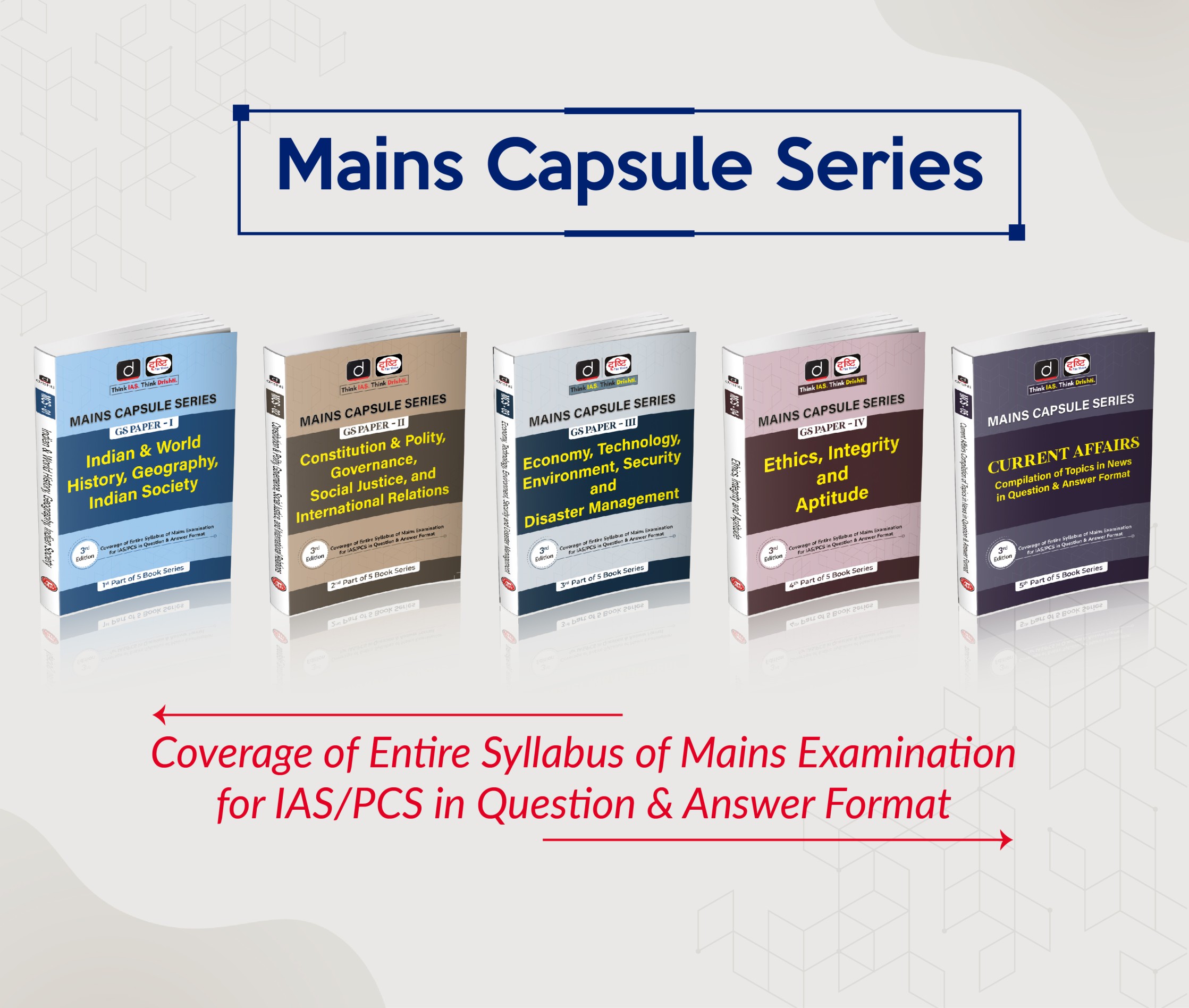
Social Justice
Kala-azar Disease
For Prelims: Kala-azar Disease, Leishmaniasis, Black Fever, Global Programme to Eliminate Lymphatic Filariasis (GPELF), National Kala-azar Elimination Programme, National Vector Borne Disease Control Programme (NVBDCP)
For Mains: Initiatives related to the Control of Vector-Borne Diseases.
Why in News?
Kala-azar cases in India declined by 98.7% between 2007 and 2022, from 44,533 to 834 and 632 endemic blocks (99.8%) spread across Bihar, Uttar Pradesh, Jharkhand, and West Bengal have received elimination status (less than one case per 10,000).
- The only block that is still in the endemic category is Littipara in the Pakur district of Jharkhand (1.23 cases per 10,000 population).
What is Kala-azar Disease?
- About:
- It is also known as Visceral Leishmaniasis or Black Fever or Dumdum Fever.
- There are three types of Leishmaniasis:
- Visceral Leishmaniasis, which affects multiple organs and is the most serious form of the disease.
- Cutaneous Leishmaniasis, which causes skin sores and is the most common form.
- Mucocutaneous Leishmaniasis, which causes skin and mucosal lesions.
- There are three types of Leishmaniasis:
- It is a deadly parasitic disease caused by the protozoa parasite Leishmania and mainly affects the people living in Africa, Asia and Latin America.
- The disease can cause death, if left untreated.
- It is also known as Visceral Leishmaniasis or Black Fever or Dumdum Fever.
- Global and National Status:
- According to the World Health Organization (WHO), Kala-azar is the second deadliest parasitic disease in the world, and as of November, 2022, about 89% of global cases are reported from eight countries: Brazil, Eritrea, Ethiopia, India, Kenya, Somalia, South Sudan, and Sudan.
- India contributes about 11.5% of total cases of Kala-azar reported globally.
- Over 90% of kala-azar cases in India are reported from Bihar and Jharkhand, while Uttar Pradesh and West Bengal have achieved their elimination targets at the block level.
- Transmission:
- It is transmitted to humans by the bite of an infected female phlebotomine sandfly.
- Signs and Symptoms:
- Fever, weight loss, anemia, and enlargement of the liver and spleen.
- Prevention:
- Prevention of kala-azar involves measures to reduce the breeding sites of sandflies and to protect people from sandfly bites.
- This can be achieved through the use of insecticides, bed nets, and repellents, as well as the improvement of housing conditions and access to clean water and sanitation.
- The WHO also recommends Mass Drug Administration (MDA) in areas where the disease is endemic.
- Prevention of kala-azar involves measures to reduce the breeding sites of sandflies and to protect people from sandfly bites.
- Treatment:
- The treatment of kala-azar involves the use of drugs, such as sodium stibogluconate and meglumine antimoniate.
- The WHO recommends a combination of two or more drugs for the treatment of kala-azar, as monotherapy has a higher risk of treatment failure and drug resistance.
- The treatment of kala-azar involves the use of drugs, such as sodium stibogluconate and meglumine antimoniate.
- Related Initiatives:
- Global:
- WHO’s New Roadmap for 2021–2030: To prevent, control, eliminate and eradicate a set of 20 diseases, termed neglected tropical diseases, by 2030.
- The WHO has also established the Global Programme to Eliminate Lymphatic Filariasis (GPELF), which aims to eliminate lymphatic filariasis, onchocerciasis, and Kala-azar by MDA.
- The target set by GPELF in 2000 to eliminate these diseases globally by 2020 was not achieved. Despite setbacks due to Covid-19, WHO will accelerate work to achieve this target by 2030.
- Indian:
- The central government has taken several steps to achieve its goal of eliminating kala-azar from India by 2023, including building pucca houses through the PM-AWAS yojana, rural electrification, testing, treatment, periodic high-level review, and award distribution.
- The Centre is also supporting the states in active case detection, surveillance, treatment, and supply of diagnostic kits, medicines, and sprays.
- National Kala-azar Elimination Programme
- The National Health Policy-2002 set the goal of Kala-azar elimination in India by the year 2010 which was revised to 2015.
- India signed a Tripartite Memorandum of Understanding (MoU) with Bangladesh and Nepal to achieve Kala-azar elimination from the South-East Asia Region (SEAR).
- Presently, all programmatic activities are being implemented through the National Vector Borne Disease Control Programme (NVBDCP) which is an umbrella programme and is subsumed under National Health Mission (NHM).
- The central government has taken several steps to achieve its goal of eliminating kala-azar from India by 2023, including building pucca houses through the PM-AWAS yojana, rural electrification, testing, treatment, periodic high-level review, and award distribution.
- Global:
UPSC Civil Services Examination, Previous Year Question (PYQ)
Q. Consider the following statements: (2017)
- In tropical regions, Zika virus disease is transmitted by the same mosquito that transmits dengue.
- Sexual transmission of Zika virus disease is possible.
Which of the statements given above is/are correct?
(a) 1 only
(b) 2 only
(c) Both 1 and 2
(d) Neither 1 nor 2
Ans: (c)
Exp:
- Zika virus is a flavivirus which was first discovered in 1947 in monkeys and then in humans in Uganda in 1952.
- Both Zika and Dengue have similarities in terms of symptoms of fever, skin rashes, conjunctivitis, muscle and joint pain, malaise, and headache. In addition to this, the mode of transmission is also same for both the diseases, i.e., both are spread by Aedes aegypti and Aedes albopictus species of mosquitoes. Hence, statement 1 is correct.
- Modes of Zika Transmission
- Mosquito bites
- From mother to child during pregnancy, which can cause microcephaly and other severe fetal brain defects. Zika virus has also been found in breast milk.
- Sexual transmission from infected partner. Hence, statement 2 is correct.
- Through blood transfusion.
- Therefore, option (c) is the correct answer.


Important Facts For Prelims
Vishwa Hindi Diwas
Why in News?
Vishwa Hindi Diwas (VHD) or World Hindi Day (WHD) is celebrated every year on 10th January to promote the Hindi language all around the world.
- Whereas Hindi Diwas is celebrated on 14th September annually, which focuses largely on recognition of the Hindi language in India.
What is Vishwa Hindi Diwas?
- About:
- It was first celebrated in 2006 to commemorate the anniversary of the first World Hindi Conference which was held in Nagpur on 10th January, 1975.
- It marks the day when Hindi was first spoken in the United Nations' General Assembly in 1949. It is also celebrated by Indian embassies located in various parts of the world.
- The World Hindi Secretariat building was inaugurated in Port Louis, Mauritius in 2018.
- It was first celebrated in 2006 to commemorate the anniversary of the first World Hindi Conference which was held in Nagpur on 10th January, 1975.
- Significance:
- The purpose of this day is to create awareness about the Indian language and promote it as a global language around the world. It is also used to create awareness about the usage of the Indian language, and about the issues persisting around the usage and promotion of the Hindi language.
- National Hindi Day:
- The National Hindi Day is celebrated every year in India on September 14 to mark the day of adoption of Hindi as the official language by the Constituent Assembly of India in 1949.
- Kaka Kalelkar, Maithili Sharan Gupta, Hazari Prasad Dwivedi, Seth Govindadas made important contributions to make Hindi the official language.
- Hindi is also an eighth schedule language.
- Article 351 pertains to ‘Directive for development of the Hindi language’.
- The National Hindi Day is celebrated every year in India on September 14 to mark the day of adoption of Hindi as the official language by the Constituent Assembly of India in 1949.
- Government Initiatives to Promote Hindi:
- The Central Hindi Directorate was established in 1960 by the Government of India under the Ministry of Education.
- Indian Council for Cultural Relations (ICCR) has established ‘Hindi Chairs’ in various foreign universities/institutions abroad.
- LILA-Rajbhasha (Learn Indian Languages through Artificial Intelligence) is a multimedia based intelligent self-tutoring application for learning Hindi.
- E-Saral Hindi Vakya Kosh and E-Mahashabdkosh Mobile App, both initiatives of the Department of Official Language, aim to harness information technology for the growth of Hindi.
- Rajbhasha Gaurav Puraskar and Rajbhasha Kirti Puraskar recognise contributions to Hindi.
Hindi Language
- Hindi got its name from the Persian word Hind, meaning 'land of the Indus River'. Turk invaders in the early 11th century named the language of the region Hindi, 'language of the land of the Indus River'.
- It is the official language of India, English being the other official language.
- Hindi is also spoken in some countries outside India, such as in Mauritius, Fiji, Suriname, Guyana, Trinidad & Tobago and Nepal.
- Hindi in its present form emerged through different stages, during which it was known by other names. The earliest form of old Hindi was Apabhramsa. In 400 AD Kalidas wrote a romantic play in Apabhramsa called Vikramorvashiyam.
- The modern Devanagari script came into existence in the 11th century.


Important Facts For Prelims
Wayanad Wildlife Sanctuary
Why in News?
Recently, a Human-Animal Conflict occurred where a local man was attacked by an Elephant and a herd of elephants raided a field of 500 plantains.near Wayanad Wildlife Sanctuary, Kerala.
- Human-animal conflict has become a serious wildlife management problem in Kerala in the last few years. People living on the fringes of reserve forests and sanctuaries have a heightened sense of insecurity now.
What is Human-Animal Conflict?
- About: It refers to struggles that arise when the presence or behavior of wildlife poses actual or perceived direct, recurring threats to human interests or needs, often leading to disagreements between groups of people and negative impacts on people and/or wildlife.
- Causes: Human population expansion, habitat degradation and fragmentation, land use transformation and rising densities of livestock in protected areas are considered as the major causes of Human-Wildlife conflict.
What are the Key Points of Wayanad Wildlife Sanctuary?
- Located in Kerala, Wayanad Wildlife Sanctuary (WWS) is an integral part of the Nilgiri Biosphere Reserve. It was established in 1973.
- Nilgiri Biosphere Reserve was the first from India to be included in the UNESCO designated World Network of Biosphere Reserves (designated in 2012).
- Other wildlife parks within the Reserve are: Mudumalai Wildlife Sanctuary, Bandipur National Park, Nagarhole National Park, Mukurthi National Park and Silent Valley.
- Spread over 344.44 sq km, Wayanad Wildlife Sanctuary is contiguous to the tiger reserves of Nagerhole and Bandipur of Karnataka and Mudumalai of Tamil Nadu.
- Kabini river (a tributary of Cauvery river) flows through the sanctuary.
- The forest types include South Indian Moist Deciduous forests, West coast semi-evergreen forests and plantations of teak, eucalyptus and Grewelia.
- Elephant, Gaur, Tiger, Panther,Sambar, Spotted deer, Barking deer, Wild boar, Sloth bear, Nilgiri langur, Bonnet macaque, Common langur, Wild dog, common otter, Malabar giant squirrel etc are the major mammals.
What are the Protected Areas in Kerala?
What is the Conservation Status of Elephants?
- International Union for Conservation of Nature (IUCN) Red List of threatened species:
- African Forest Elephant- Critically Endangered
- African Savanna Elephant- Endangered
- Asian Elephant- Endangered
- Convention of the Migratory species (CMS): Appendix I
- Wildlife (Protection) Act, 1972: Schedule I
UPSC Civil Services Examination Previous Year Question (PYQ)
Q1. With reference to Indian elephants, consider the following statements: (2020)
- The leader of an elephant group is a female.
- The maximum gestation period can be 22 months.
- An elephant can normally go on calving till the age of 40 years only.
- Among the States in India, the highest elephant population is in Kerala.
Which of the statements given above is/are correct?
(a) 1 and 2 only
(b) 2 and 4 only
(c) 3 only
(d) 1, 3 and 4 only
Ans: (a)
Exp:
- The elephant herd is led by the oldest and largest female member (known as the matriarch). This herd includes the daughters of the matriarch and their offspring. Hence, statement 1 is correct.
- Elephants have the longest-known gestational (pregnancy) period of all mammals, lasting up to 680 days (22 months). Hence, statement 2 is correct. Females between 14 - 45 years may give birth to calves approximately every four years with the mean interbirth intervals increasing to five years by age 52 and six years by age 60. Hence, statement 3 is not correct.
- As per Elephant Census (2017), Karnataka has the highest number of elephants (6,049), followed by Assam (5,719) and Kerala (3,054). Hence, statement 4 is not correct.
- Therefore, option (a) is the correct answer.
Q2. Which of the following Protected Areas are located in Cauvery basin? (2020)
- Nagarhole National Park
- Papikonda National Park
- Sathyamangalam Tiger Reserve
- Wayanad Wildlife Sanctuary
Select the correct answer using the code given below:
(a) 1 and 2 only
(b) 3 and 4 only
(c) 1, 3 and 4 only
(d) 1, 2, 3 and 4
Ans: (c)


Important Facts For Prelims
Bird Species Count in Deepor Beel
Why in News?
Recently, Guwahati Wildlife Division of the Assam Forest Department conducted the 2nd Bird Species Count Exercise after February 2022 in Deepor Beel Wetland, which is the only Ramsar Site in Assam.
- Altogether 26,747 birds belonging to 96 species were recorded during a bird count at the Deepor Beel wetland. There were 10,289 individuals across 66 species in 2022.
- The bird count revealed greater species diversity and an increase in the total number of species.
What is Deepor Beel?
- About:
- It is one of the largest freshwater lakes in Assam and an Important Bird Area by Birdlife International.
- Deepor Beel has been designated as a Ramsar Site in November, 2002
- It is located towards the southwest of Guwahati city, Assam and is the erstwhile water channel of River Brahmaputra.
- The lake expands up to 30 sq. km in summer and reduces to about 10 sq. km in the winter.
- The Assam Forest Department manages the 4.1 sq km Deepor Beel Wildlife Sanctuary in the central part of the greater wetland named Deepor Beel.
- Importance:
- It constitutes a unique habitat for aquatic flora and avian fauna.
- It has both biological and environmental importance besides being the only major storm-water storage basin for Guwahati city.
- It provides a means of livelihood for a number of local families.
- In 2021 six young girls from the fishing community from Assam have developed a biodegradable and compostable yoga mat called ‘Moorhen Yoga Mat’.
- Deepor Beel adjoins the Rani Reserve Forest from where herds of elephants come periodically to forage in the wetland.
- Concerns:
- Deepor Beel has also suffered contamination because of a garbage dump on its edge at Paschim Boragaon.
- Its water has become toxic and it has lost many of its aquatic plants that elephants would feed on.
- It has for decades been threatened by a railway track — set to be doubled and electrified — on its southern rim, a garbage dump, and encroachment from human habitation and commercial units.
What are the Other Protected Areas in Assam?
- Assam has 7 national parks and 17 wildlife sanctuaries.
UPSC Civil Services Examination, Previous Year Question (PYQ)
Q. Consider the following pairs: (2013)
National Park River flowing through the Park
- Corbett National Park : Ganga
- Kaziranga National Park : Manas
- Silent Valley National Park : Kaveri
Which of the above pairs is/are correctly matched?
(a) 1 and 2
(b) 3 only
(c) 1 and 3
(d) None
Ans: (d)
- Jim Corbett National Park: River Ramganga, a tributary of river Ganga is the primary source of water for the park. Tributaries of Ramganga are Khoh, Kolhu and Mandal rivers. Hence, pair 1 is not correctly matched.
- Kaziranga National Park: It is a park hosting around two-third of total world’s one-horned rhinoceros and is circumscribed by the Brahmaputra River. The Brahmaputra forms the northern and eastern boundaries of it, whereas the Mora Diphlu forms the southern boundary. Other notable rivers within the park are the Diphlu and Mora Dhansiri. Hence, pair 2 is not correctly matched.
- Silent Valley National Park: Located in Kerala, the park’s entire stretch drains from north to south by River Kuntipuzha. It is part of the Nilgiri Biosphere Reserve. Hence, pair 3 is not correctly matched.
- Therefore, option (d) is the correct answer.


Rapid Fire
Rapid Fire Current Affairs
Medicine for Alzheimer’s Disease
The US Food and Drug Administration (USFDA) has granted fast-track approval to an Alzheimer’s medicine - Lecanemab (marketed as Leqembi). In its initial tests, it has shown reduction in amyloid beta protein deposition in the brain (a classic symptom of the disease) in mild cases.
Alzheimer’s Disease is a neurological disorder which causes brain cells to degenerate and die resulting in memory loss, speaking/writing problems, poor judgement, changes in mood and personality, confusion with time or place, etc. it is the most common cause of dementia among older adults.
Read More - Alzheimer's Disease
India Forex Reserves Fell by USD 70 Bn in 2022
After 3 consecutive years of rise, India’s forex reserves declined by $70 bn in 2022 on account of rising inflation and interest rates.
This decline can be primarily (about 55-60% of total loss) attributed to the valuation loss of other foreign currencies (€, £, ¥) against USD (that India held as reserves). Another major cause is the FPI withdrawal.
Due to this, the number of months of imports that can be covered through India’s reserves have also declined (from 13 in 2021-22 to 9.2 in 2022-23).
Holding forex reserves reduces the likelihood of BoP crises and helps preserve economic and financial stability against disordered market conditions. India's Forex Reserves include- Foreign Currency Assets, Gold reserves, Special Drawing Rights, Reserve position with the IMF.
Read More - Forex Reserves
Young Professionals Scheme
On the 17th Pravasi Bharatiya Divas, India and the UK have decided to launch Young Professionals Scheme (YPS) under which, up to 3,000 of their degree-holding citizens (age 18-30) will be permitted to live and work in each other’s countries for a period of 2 years.
The YPS was conceived as part of an India-U.K. Migration and Mobility MoU (signed in 2021). The scheme will have an initial running period of 3 years and is expected to be launched by March 2023.
Read More - India-UK Relations
Kilauea Volcano Erupts Again
Recently, Hawaii’s Kilauea volcano erupted again after a brief pause. The eruption in the volcano’s crater started in Jan 2022.
The US Geological Service (USGS) has warned the locals about dangerous volcanic fumes containing sulphur dioxide, Pele’s hair (tiny strands of drifting lava) (Pele is the Hawaiian goddess of fire and volcanoes) and other volcanic particles.
Kilauea is among the most active ones on the planet which last erupted in Sept 2021 and continued for 16 months. The eruption in 2018 destroyed 700 homes, sending rivers of lava across farms and into the ocean.
In Nov-Dec 2022, Hawaii’s Mauna Loa also erupted for the first time in 38 years. Volcanic eruptions have significant cultural and spiritual meanings for the native Hawaiians.
Read More - Kilauea Volcano, Mauna Loa Volcano






